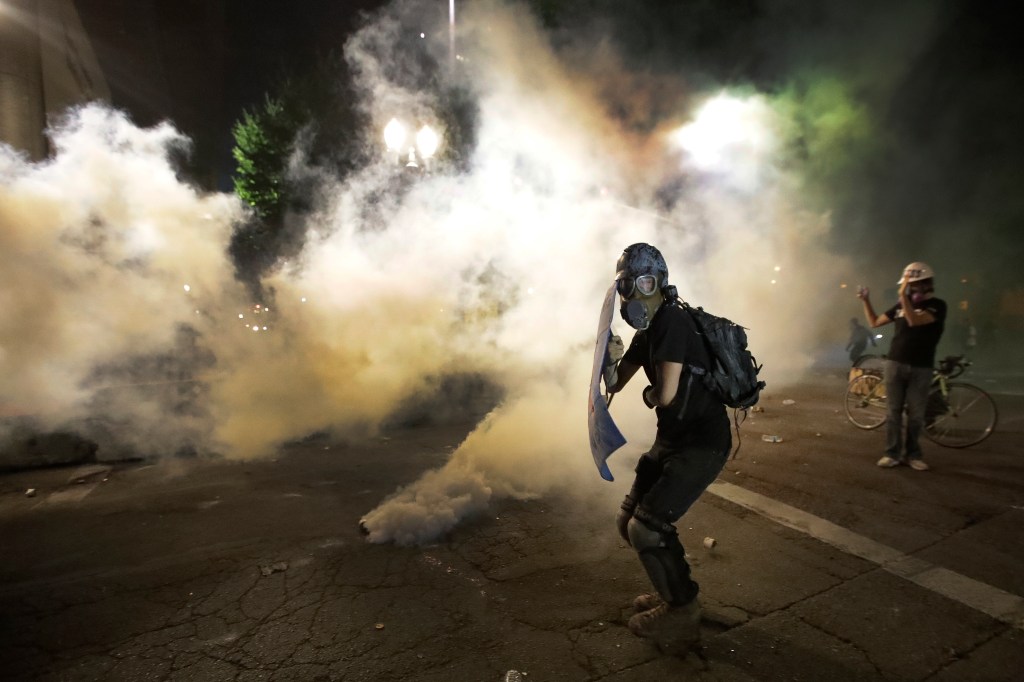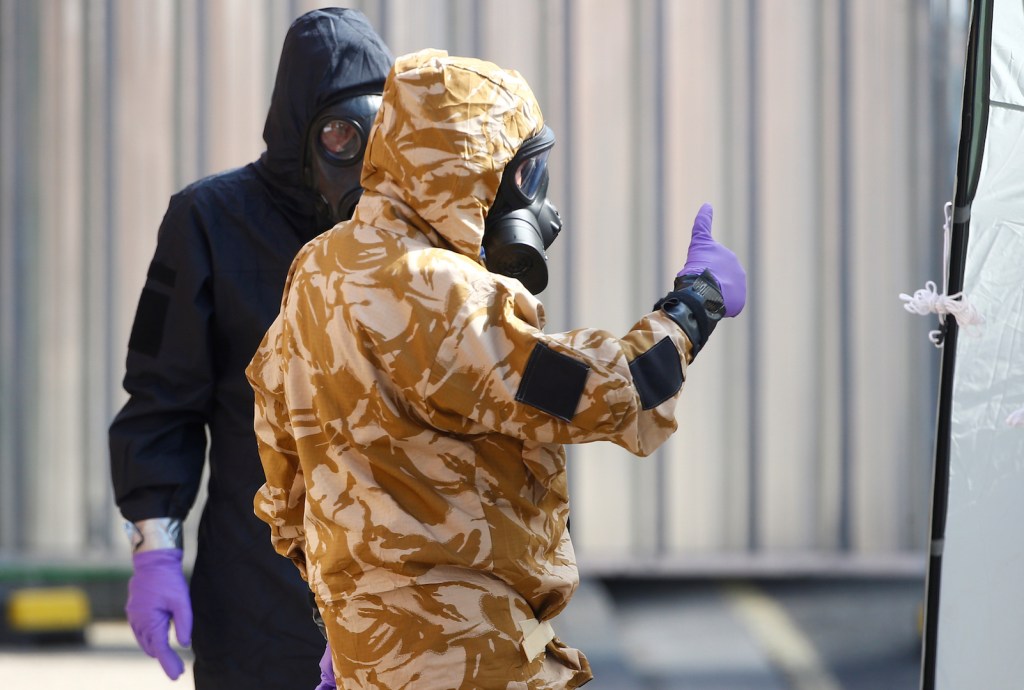When the VHS tape dispatched to my family by the Chemical Stockpile Emergency Preparedness Program begins to roll, it simply looks, at first, like a poorly-acted instructional video from a 1990s health class. Part of a larger kit—including, inexplicably, duct tape and scissors—aimed at helping community members “shelter in place” in case of disaster, the video’s corny melodrama almost distracts from its surreal, quasi-apocalyptic purpose.
“Honey, did you see hear anything about a test today?” A balding man in an unsightly sweater vest calls anxiously, poking his head out of a suburban home.
Videos by VICE
“No. No, I didn’t. Do you think it’s real this time?” The wife replies, glancing up from planting marigolds with a deep fear in her eyes. “Come on kids, let’s get inside right now.”
In the distance, sirens screech and wail against a too-blue sky.
Around the kitchen table, facial expressions are tight-jawed and on the brink of trembling as the family turns the knob on their emergency broadcast radio. Is it really happening?
An inhale. A pause.
“This is a test of the emergency alert system…” An automated voice robotically barks over the speaker, and the mother exhales in relief.
Whew. It was only a test. The family in the video has survived today.
But what about tomorrow? What about reality?
Tomorrow, the fear of disaster still looms. Tomorrow, we might all be exposed to nerve gas.
***
Madison County, Kentucky was, in many ways, an idyllic place to grow up. The ebb and flow of tobacco fields, muddy-bottomed creeks and thicketed forests provided never-ending stretches of land to explore and ogle. Each year, prospective homecoming kings and queens paraded down Main Street before the big football game, the community waving back to their sons and daughters.
Upon first glance, it’s wholly charming.
In conversation, the piles are primarily just called “the nerve gas.”
The quaint town of my heart, though, has an unexpected dark side—and one of international concern. Madison County is home to one of the final two active stockpiles of chemical weapons in the United States, including nerve agents (VX and sarin) as well as mustard gas.
Of the tens of thousands of tons of lethal chemical weapons developed (but never used) by the United States during World War II, roughly 2 percent reside on the base in Kentucky, with seven other outposts initially established across the US.

Toxic chemical workers inspect palettes of chemical weapons. Photo: BGAD/US Army
Located on 14,594 sprawling acres just miles from my parents’ backyard, the Blue Grass Army Depot (BGAD) houses 902 bunker-style “igloos” full of chemical warfare weapons (roughly 523 tons) designed to maim enemies en masse. The BGAD has been home to mustard gas since 1941, and nerve agents since the early 1960s.
Nerve gas in any form has become synonymous with the kind of unconscionable chemical warfare the United States now rebukes almost in whole (ISIS, among other terrorist groups, has recently reportedly engaged in chemical warfare using nerve agent). Unfortunately, the remnants of a time when our country wasn’t dead-set against it are still present.
When nerve gas is inhaled, it causes the nervous system to shut down bit-by-bit, eventually leading to complete respiratory depression and death. Even in small increments, the more a person is exposed to nerve gas over time, the more severe and long lasting their neurological damage becomes. Mustard gas, on the other hand, is both a carcinogen and mutagenic, causing massive blisters and third-degree burns on the lungs and skin of victims. Both are unequivocally designed to kill—and hard to destroy.
When I was a child, it was all but impossible for me to understand the danger and magnitude of the substances located at the Blue Grass Army Depot just a hop, skip and jump from where I kicked rec league soccer balls and visited my pediatric dentist. Explaining chemical demilitarization to children wasn’t top on the priority list for any of our school leaders, and the stockpiles were talked about with such passivity there seemed to be little reason for alarm. In conversation, the piles are primarily just called “the nerve gas.”
It wasn’t until September 11, 2001 that their presence—and the decades-long fight over how to get rid of them—was abruptly brought to my attention.

Illustration: Shaye Anderson
With fears heightened about potential terrorist bombings of BGAD and community exposure to the gases, my middle school began holding “nerve gas drills” due to our close proximity to the depot. During these test runs, all students were hustled into buses and faux-evacuated through the town, in theory saving us from certain doom at the hands of our neighboring chemical weapons. The protocol we followed would likely make little sense in the throes of real disaster, but, for me, it served a decidedly larger personal purpose.
Suddenly, my eyes were opened to the deeply disturbing nature the substance inside the grass-covered igloos at BGAD and the people working to do something about it—namely, the Kentucky Environmental Foundation.
The Kentucky Environmental Foundation (KEF) officially sprung forth in 1991 from the efforts of movement figurehead Craig Williams, who had been working to heighten awareness about the county’s weapons stockpile since 1984. After returning from the Vietnam War, Williams was shocked to learn that the Department of Defense planned to incinerate the remaining chemical weapons at BGAD, giving almost no regard to the health and safety of the surrounding community. (At the time, another proposed option was dumping the chemical weapons into the ocean, with almost 32,000 tons of nerve and mustard agents already disposed of in this fashion.) His personal quest quickly snowballed into a movement that, ultimately, stopped the incineration plan in its tracks.
KEF’s firmly grassroots approach to organizing helped to kickstart a conversation about the safest means of disposal for the weapons, all the while pushing back against the community threat posed by incineration. KEF’s work also laid the foundation for a more collective national voice on the issue, as impacted towns and concerned citizens across the country joining together to speak out against chemical weapon incineration.
By 1997, Congress had ratified the Chemical Weapons Convention treaty, which directed all member nations to destroy their chemical weapons and production facilities over a set timeline. A key question was quickly shoved to the forefront: How—exactly—do we do that in Kentucky?
After years of hostility, perpetually leaky bunkers, lines-in-the-sand and shouting match-style debate, officials eventually decided on the (relatively newfangled) supercritical water oxidation method as the best means of neutralization for the BGAD stockpile. This process works by pushing water past its thermodynamic critical point, after which it becomes a fluid with properties capable of breaking down hazardous waste like halogenated matter and, yes, nerve agent.
Dumping? Incineration? Be gone. Craig Williams—and the community—had won.
***
It’s difficult to assess whether or not my general childhood ignorance to the weapons was for the best. After all, I was (and am) a tremendous worrier, so the realization that these chemicals were occasionally, quietly leaking mere miles down the road likely would’ve sent me into a catatonic state.
Still, it feels strange to harbor so many childhood memories of being at BGAD—gifting someone a Matchbox 20 poster at an on-base pool party, losing the limbo contest during a wedding reception at the depot’s officers’ club—with only a faint reckoning that there were lethal chemical weapons in my immediate proximity. (This kind of civilian entry to the base has been heavily restricted since a gunman opened fire on two Chattanooga, Tennessee military centers in July, killing five service officers.)
“What we got was an experimental procedure unproven at a large scale.”
Since 2005, rapid progress has been made toward constructing the Blue Grass Chemical Agent-Destruction Pilot Plant, where the nerve agent portion of Kentucky’s chemical weapons will be safely destroyed using the supercritical water oxidation technology.
The plan in place seems to suit all interested parties, many of whom are part of the robust community-based Chemical Destruction Community Advisory Board. Comprised of elected officials, environmental experts, military personnel and more, the working group has been tackling the intricate ins and outs of the plant’s incredibly elaborate construction and systemization.
“Everyone is really working together now, it’s not antagonistic like it used to be,” said Williams. “The military understands now that the community has a real voice and it’s important to listen. They didn’t get that for a long time.”
Of course, not everyone agrees with the destruction method of choice. Retired Colonel Jack Edwards, the former commanding officer of the Blue Grass Army Depot until 2002, still believes incineration would have been a better path.
“Kentucky federal legislators were swayed by a fringe group of radical naysayers who never trusted the government. They are smokestackaphobians,” Col. Edwards said in an e-mail. “‘If it burns it must be producing a toxic cloud!’ On the contrary: It is cleaner than most power plants. However, this minority of folks got the government’s ear [and] they demanded something else. No smoke stacks. What we got was an experimental procedure unproven at a large scale.” (Full disclosure: Col. Edwards is the father of my high school boyfriend.)

Blue Grass Chemical Agent-Destruction Pilot Plant. Photo: US Army
Neutralizing the chemical weapons is slow process, and one that won’t be completely finished for many years. The mustard gas has proven to be particularly problematic since it has hardened in its shells, meaning that it can’t be processed using the same destruction technology as the nerve agents. Instead, it will be detonated using explosive destruction technology, a method through which the chemical weapon is (you guessed it) blown up in a controlled environment. A similar approach will be enacted to destroy solidified mustard gas stockpiles in Pueblo, Colorado.
Currently, all chemical weapons at BGAD are expected to be destroyed by 2023 with project closure slated for 2026—almost a decade past the 2017 deadline set by Congress in 2007. Whether or not the timeline will be shifted (or Congress will offer an extension to the original drop dead date) remains to be seen.
In order to commemorate the 25-year official anniversary of the Kentucky Environmental Foundation’s founding and their decades-long fight, the group has created a documentary, NERVE, which will “expose audiences to the realities of inappropriate…[chemical warfare] disposal approaches, and the dangers it poses for small towns and communities across the globe.”
Until it is completely destroyed, though, all of us with ties to Kentucky now wait—hopefully—for a positive outcome. We wait for the year when that “shelter in place” kit doesn’t arrive like clockwork. The year the chemical stockpile has finally vanished. That might just be the year I think about going back home.
All Fronts is a series about technology and forever war. Follow along here.



